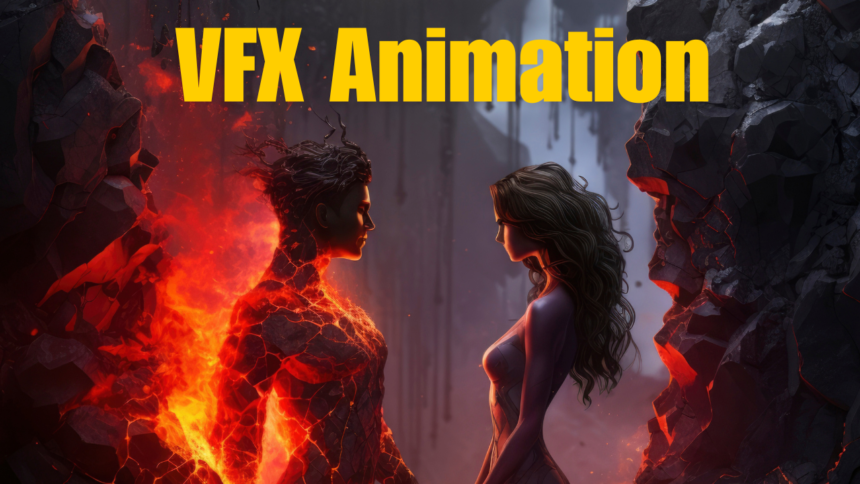Here Is A Full Comprehensive Introduction Of VFX Animation
VFX Animation: In today’s digital age, the demand for visual content is higher than ever, and with it comes a growing interest in the fields of animation and visual effects (VFX). Whether you’re a professional in the industry or simply a creative enthusiast, understanding the distinctions between “VFX Animation,” “Animation and VFX,” and “Animation vs VFX” is crucial. These terms often surface in discussions about film production, video game design, and digital media, but they aren’t always used interchangeably. Each of these terms represents a specific aspect of the visual storytelling process. This article delves into the differences, similarities, and applications of these concepts, providing a comprehensive guide to help you navigate this exciting field.

Know More About VFX Animation
VFX Animation
VFX Animation, or Visual Effects Animation, refers to the integration of live-action footage and computer-generated imagery (CGI) to create environments, objects, creatures, or effects that would be impractical or impossible to capture on film. VFX Animation is a pivotal part of modern filmmaking and game design, allowing creators to push the boundaries of what is visually possible.
Here Are the Key Components of VFX Animation:
- Computer-Generated Imagery (CGI): This is the cornerstone of VFX Animation. CGI involves creating digital environments, characters, and effects that can seamlessly blend with live-action footage. It is used in everything from blockbuster films to video games and commercials.
- Motion Capture: Often used in conjunction with CGI, motion capture records the movement of actors and applies it to digital characters, giving them realistic motion and expression. This technology has been crucial in creating lifelike characters in films like “Avatar” and “The Lord of the Rings.”
- Compositing: This process involves combining multiple visual elements from different sources into a single image. Compositing is essential in VFX Animation as it allows the seamless integration of CGI with live-action footage.
- Rendering: After all the elements of a scene are created, they need to be rendered. Rendering converts the digital models, textures, and lighting into final images or animations, ready for viewing.
Applications of VFX Animation:
- Film and Television: VFX Animation is widely used in movies and TV shows to create fantastical worlds, explosive action scenes, and lifelike creatures that would be impossible to film in reality.
- Video Games: In the gaming industry, VFX Animation helps create immersive environments, realistic characters, and engaging visual effects that enhance the player’s experience.
- Advertising: VFX Animation is also popular in advertising, where brands use it to create memorable commercials with eye-catching visuals.
Exploring Animation and VFX
Animation and VFX
The term “Animation and VFX” encompasses both traditional animation techniques and the integration of visual effects. Animation and VFX are often paired together in the creative industries because they complement each other in bringing stories to life. While animation involves creating a series of images that move in succession, VFX focuses on adding realism or enhancing scenes that have been animated or filmed.
Key Differences Between Animation and VFX:
- Process:
- Animation: The process involves creating sequences of images or frames that simulate movement. This can be done using traditional hand-drawn techniques, stop-motion, or computer-generated methods (CGI).
- VFX: Involves adding special effects to live-action footage or animated scenes. These effects can be as simple as color correction or as complex as creating entire environments or characters digitally.
- Application:
- Animation: Primarily used in films, TV shows, video games, and commercials. It’s the backbone of any visual medium that requires the depiction of movement.
- VFX: Applied when a scene requires elements that are difficult or impossible to film in reality. This could include creating futuristic cities, replicating natural disasters, or generating magical creatures.
- Tools and Techniques:
- Animation: Uses tools like Adobe Animate, Toon Boom Harmony, and Autodesk Maya for creating frame-by-frame animation or 3D models.
- VFX: Involves software like Adobe After Effects, Nuke, and Autodesk Flame to integrate effects with live-action footage or CGI elements.
Collaboration Between Animation and VFX:
Animation and VFX teams often work closely together, especially in projects like feature films or large-scale video games. For instance, an animated film may require VFX for scenes that involve complex lighting effects, weather conditions, or other elements that enhance the visual storytelling. The integration of these two fields allows for the creation of visually stunning and narratively compelling content.
Animation vs VFX: A Comparative Analysis
Animation vs VFX
When it comes to the debate of “Animation vs VFX,” it’s important to recognize that these two disciplines, while distinct, are often complementary. Understanding their differences helps in appreciating how they contribute to the final visual product.
Animation:
- Definition: Animation is the art of creating moving images through a sequence of individual frames. It can be 2D, 3D, or stop-motion, and it’s used to tell stories, create characters, and depict motion.
- Techniques: Animation can be done by hand (traditional animation), through computer software (3D animation), or by manipulating physical objects frame by frame (stop-motion).
- Examples: Classic Disney films like “The Lion King” (2D animation), Pixar’s “Toy Story” (3D animation), and Tim Burton’s “The Nightmare Before Christmas” (stop-motion animation).
VFX (Visual Effects):
- Definition: VFX involves the creation or manipulation of imagery outside of live-action footage. It’s primarily used to create scenes that cannot be captured by a camera, such as otherworldly landscapes, fantasy creatures, or explosions.
- Techniques: VFX relies on digital technology, including CGI, motion capture, compositing, and rendering. It often involves combining these elements with live-action footage to create a seamless final product.
- Examples: The dragon Smaug in “The Hobbit,” the destruction of the Starkiller Base in “Star Wars: The Force Awakens,” and the various superhero abilities showcased in Marvel films.
When to Use Animation vs VFX:
- Animation: Ideal for projects where the entire world is created from scratch, such as animated films, cartoons, and video games. Animation is used when the focus is on storytelling through characters and movements that don’t require real-world filming.
- VFX: Best for enhancing live-action footage, creating scenes that require a mix of reality and fantasy. VFX is crucial in films where the narrative demands elements that would be dangerous, expensive, or impossible to film.
Advantages and Challenges:
- Animation Advantages: Full creative control over the environment and characters, ability to create any scenario imaginable, and versatility across different media.
- Animation Challenges: Time-consuming process, requires skilled artists and animators, and can be resource-intensive.
- VFX Advantages: Enhances realism in live-action footage, allows filmmakers to create spectacular scenes, and is essential for high-budget films.
- VFX Challenges: High costs, reliance on advanced technology, and the need for seamless integration with live-action footage to avoid breaking the viewer’s immersion.
Frequently Asked Questions (FAQs)
Q1: What is the main difference between VFX Animation and traditional animation?
A: The main difference lies in the application. Traditional animation focuses on creating a sequence of images that simulate movement, whereas VFX Animation integrates computer-generated imagery with live-action footage to create effects that are difficult or impossible to capture in reality.
Q2: Can VFX be used in animated films?
A: Yes, VFX can be used in animated films to enhance certain scenes, add realistic effects like lighting and weather, or create complex environments that are challenging to animate traditionally.
Q3: Which is more challenging: Animation or VFX?
A: Both Animation and VFX have their challenges. Animation requires meticulous attention to detail and time to create fluid motion, while VFX demands technical expertise in integrating effects with live-action footage. The difficulty varies depending on the project’s scope and the specific techniques used.
Conclusion
In the evolving world of digital content creation, both Animation and VFX play critical roles. While they can be used independently, their true potential is often realized when combined. Understanding the nuances of “VFX Animation,” “Animation and VFX,” and “Animation vs VFX” allows creators to make informed decisions about their projects, ensuring that their visual storytelling is both compelling and cutting-edge.
By mastering these disciplines, you open the door to endless creative possibilities, whether you’re producing an animated short, working on a blockbuster film, or developing the next hit video game. As technology advances, the line between Animation and VFX continues to blur, offering new opportunities for artists and storytellers alike.


